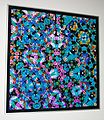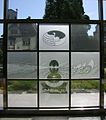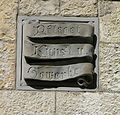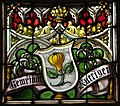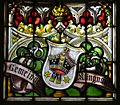Old Cantonal School Aarau
| Old Cantonal School Aarau | |
|---|---|
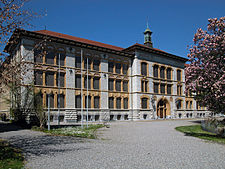
|
|
| Front of the main building (Albert Einstein House) | |
| type of school | Cantonal school ( grammar school ) |
| founding | 1802 |
| address |
Bahnhofstrasse 91 |
| place | Aarau |
| Canton | Aargau |
| Country | Switzerland |
| Coordinates | 646 347 / 249345 |
| carrier | Canton of Aargau, Department of Education, Culture and Sport (BKS) |
| student | 1400 |
| Teachers | approx. 190 |
| management | Dr. Andreas Hunziker |
| Website | www.altekanti.ch |
The Alte Kantonsschule Aarau (AKSA) (colloquially «Alte Kanti») on Bahnhofstrasse in Aarau was founded in 1802 and is the oldest non-church high school in Switzerland . Since the Einsteinhaus has an observatory, a public, free astronomy course is held there every year.
history
From 1802 to 1896 the canton school was housed in today's Amthaus (canton police) on the Laurenzenvorstadt . The mountain director Johann Samuel von Gruner , the factory owner Johann Rudolf Meyer and the writer Andreas Moser , who created Switzerland's first gymnasium here, were involved in the establishment. The founders were strongly influenced by Pestalozzi's ideas . The school was non-denominational and saw itself as a reform school. The first director was Georg Franz Hofmann , the secretary of the Helvetic government. Until 1813 the school was private. Today's Einsteinhaus, the main building, was inaugurated around 1896. In 1917 the extension to the Einsteinhaus with observatory was moved. For a long time, the school had the reputation of being one of the best teaching institutions in Switzerland. In 1969 the Karrerhaus was completed. It was renovated in 1999/2000. In 2014, the old canton school in Aarau received the School Prize of the Science Olympiad .
classes
Courses
The Alte Kantonsschule Aarau is a public secondary school in the Canton of Aargau . In addition to the high school (MAR), the business school (WMS) and the computer science school (IMS) are also offered at the old canton school. For the first two years of high school is an accent specialist chosen for the third and fourth year, a major subject and for the fourth year, a complementary subject .
In the high school there is one sports department per class and several immersion departments (lessons in English). Since 2006, a «Nawimat» course (NATURAL SCIENCE, MAThematics) has also been available. A sports high school for top athletes is also located at the Alte Kanti.
languages
In addition to the mandatory languages English , German and French , Latin , Italian and Spanish , but also Greek , Russian , Hebrew and, since 2006, even Arabic are offered. New [reference year missing!] Also Chinese and Japanese . The small and large Latinum , the Graecum , the Hebraicum as well as the Advanced and the Proficiency can be taken at the school. Spanish students can also take the DELE diploma, while French students can obtain the DELF diploma.
music
In addition to the possibility of taking lessons on various musical instruments, there is also a choir, an orchestra and numerous ensembles. In addition to the basic subject, a major and a supplementary subject "Music" is also offered.
theatre
There is a theater course. The rehearsed pieces are performed in public approximately every six months.
Computer science
Since before 2003, typing on the keyboard had been a compulsory subject at both grammar school and WMS, although the exams at grammar school were less strict than at WMS.
Since 2010, the school has offered a computer science course (computer science secondary school, IMS) with a commercial vocational baccalaureate and a federal certificate of competence in "computer science / application development". The course consists of a three-year study period in Aarau with a 5-week internship in the second and a 4-week language stay in the third year. The fourth year is intended as a practical year.
The school has been an authorized ECDL test center since 2005, which means that ECDL diplomas can be acquired voluntarily at the grammar school, while acquisition in the WMS is part of the curriculum.
Computer science has also been a compulsory subject for all high school students since 2017. In addition to the basics of programming in several programming languages, media skills are also taught in this class.
Sports
In the past, the gymnasium next to the armory was used for physical education. Today it takes place in the Telli. The sports facility serves as a public swimming pool outside of school hours, the gyms are used by clubs such as B. the karate school Aarau, as a training and practice location.
building
Today the school consists of five buildings:
| Surname | Old name (until 2006) |
Construction year | architect | use | School building since |
named after |
|---|---|---|---|---|---|---|
| Karl Moser House | Smoking stone house | 1860 | KSB, formerly library |
Karl Moser | ||
| Albert Einstein House | Tuchschmidhaus | 1894 | Karl Moser | Teaching, rectorate | 1894 | Albert Einstein |
| Paul Karrer House ("Aquarium") | Steinmannhaus | 1969 | Barth & Zaugg | classes | 1969 | Paul Karrer |
| János Tamás House | Fehrhaus | Music store | János Tamás | |||
| Frank Wedekind House | AVA | 1933 | Richner & Anliker | Media center, cafeteria, BiG |
2008 | Frank Wedekind |
| Haeny house | classes | |||||
| Telli sports complex | Physical education, swimming |
Albert Einstein House
The Albert Einstein House is named after the important theoretical physicist (1879–1955) who attended school here for a year (1895–1896). Before 2006 it was named after the physicist and rector August Tuchschmid (1855–1939).
use
The Albert Einstein House houses the school administration rooms, an auditorium and around half of the AKSA's classrooms, especially those for the humanities and social sciences, languages and music. It was built by Karl Moser in 1894 and opened the following year.
art
On the east facade, instead of windows, there is a series of allegorical images of the sciences on the 2nd floor, for which the grammar school is preparing. They were painted by the painter Arnold Büchli (* 1885), who himself was a student of the AKSA. On the pictures you can see:
- Jurisprudence: a dejected Justitia with sword and scales, behind it an open book: «SVVM CVIQVE» ( Latin for everyone his own ).
- Theology and philosophy: The empty cross of Christ , behind it stands the winged Satan , in front of it a man is sitting by an anvil , holding a tablet with "ENS ENTI UM" (ens entium, Latin: essence of all beings = God) in his hands.
- Medicine : an oversized skull, in front of it a woman with a staff of Aesculapius who lies at the feet of a naked woman.
There used to be pictures on the west side too. These were allegories for the three directions for which the vocational school is preparing: technology, mathematics & natural sciences, and trade.
The "old men" of the three canton's student associations Argovia , Industria and Turnverein financed the purchase of six plaster statues in the vestibule and busts of famous men in the teachers' rooms in 1895. Two of the statues, Sophocles and Augustus (called "di Prima Porta") were over two meters high. The figures standing by their side, the muses Clio and Urania , an athlete and a disc- throwing youth ( Discobolos des Myron ) were deliberately chosen smaller. - "Through the busts, the pupil should see a number of men who have achieved outstanding achievements in the various areas of spiritual culture."
The vestibule and certain elements in the corridors have been ornamented by Mr. Steimer (specialist teacher for decorative painting and handicraft drawing at the trade museum). The west wall of the auditorium must have been decorated in a similar style when the building was opened. In the middle of the ornament was the Aarau coat of arms. However, in the middle of the 20th century, a horizontal ceiling was drawn in and the wall was painted uniformly white, with which the ornament also disappeared. On the wall before the sloping roof begins, an approx. 30 cm wide strip was painted on both side walls. Animals and plants could be seen. When the horizontal ceiling was removed during a renovation, these strips were in very poor condition. Only three sectors could be restored, the rest was painted green. The sloping roof, however, is still adorned on both sides by Aarau eagles. Since the walls were painted white on all sides after the renovation, the originally painted poem "Jugendgeist" by Adolf Frey had to disappear. Since they didn't just want to make it disappear, it was written on a plexiglass pane, which was then mounted on the wall.
The spirit of youth is mysterious - a wanderer on veiled paths.
A day's work full of blessings ripens to
him, who shows him the path upwards:
The boy quickly but willingly
Age strict, but cheap,
So we walk towards the light.
On the second floor in the stairwell you can find the coats of arms of the former areas, which all belonged to the canton of Aargau when it was built. They are painted directly on the plaster.
In 2003, the four cantonal student associations (Argovia, Industria, KTV Aarau and Zofingia ) donated a work of art by Ruth Maria Obrist "Installation with 200 color panels" to their 200th anniversary , which is now on display in the corridor on the first floor.
On the anniversary of the 200th anniversary of the Aargau Middle School, the city of Aarau gave her “positive and negative” by Max Matter, based on “Injection” (1998) (50 cm × 50 cm, kept in the Rector's Office). These are two tinctures on tissue paper 100 cm × 100 cm, two lambda pints (color-fast and complementary).
history
In 1891 the Feer-Herzog-Gut was acquired by the city because of its central location. An urban school district with a cantonal school, a trade school and a trade museum was to be created here while maintaining the tree population as best as possible. The competition for the entire facility was won by Karl Moser , partner of the Curjel & Moser architecture firm in Karlsruhe, who became a companion of modern architecture in Switzerland after 1900 as an architect and from 1915 as an ETH professor. For the canton school inaugurated in 1896, however, he chose the forms of the German Renaissance and was thus still completely under the spell of 19th century historicism .
In 1916, a wing extension with an observatory was planned by Karl Moser.
Paul Karrer House
The Paul Karrer House is named after the Swiss chemist and Nobel Prize winner for chemistry (1889–1971).
use
The Paul-Karrer-Haus (called: Aquarium ) serves the school mainly as a building for science classes and their internships, although some languages are also taught in it. In the 1st basement, rows of lockable boxes offer students storage space for school materials, while the school's shelters are on the 2nd basement.
art
The windows on the ground floor, together with a body depicted on them (and also on the ground floor), are a work of art by the Aargau artist Hugo Suter .
history
The school building by Barth and Zaugg from 1969, initially named "Steinmannhaus" after the scientist Paul Steinmann, exudes modernity and a belief in progress. The architects belonged to the Solothurn School , who reduced their steel, concrete and glass buildings to simple, geometric shapes based on the example of Mies van der Rohe . The tall house on a small floor plan did little to block the old park. In terms of urban development, the competition project (1961) was even more provocative: a 13-storey tower house on Bahnhofstrasse . The planned accent in a central location triggered a heated debate on high-rise buildings in the Grand Council, which ended with a compromise: The building was reduced to eight floors and relegated to the “rear part” of the park, which is why it is now adjacent to the (quieter) Laurenzenvorstadt; instead of steel / glass, it had to be performed in concrete.
It is also largely unknown that there is a ventilation shaft ( “cooling tower” ) in the building that extends from the basement to the top, but was shut down and closed during the last renovation so that it can no longer be entered today. It is located in the south-western part of the core of the building, in which there are also lifts, an emergency staircase and toilets.
Until March 13, 2005 (last measurement), there was an air-electric station on the roof of the building. The station had a fog measuring device, the flashing of which could be clearly seen from the other side of the river.
Karl Moser House
The Karl Moser House is named after its architect (1860–1936), who also built the Einstein House almost at the same time.
use
The cantonal school for vocational training (KSB) is located in the Karl-Moser-Haus, where young people who have not found an apprenticeship position after completing their compulsory schooling can complete a 10th school year. In addition, there is the training studio for fashion design on the ground floor, where apprentices are trained to become clothing designers. The AKSA library was housed on the ground floor until 2008, and in the same year it moved to the newly built Frank-Wedekind-Haus.
art
On the second floor the coats of arms of Muri and Klingnau , as well as an outdated Küttiger coat of arms, are shown as window pictures in the main staircase . The window panes were manufactured by the Adolf Kreuzer company from Zurich in 1896.
Nine artfully carved stones can be seen on the southern facade. On some you can see heraldic shields, on other figures and on one also a motto for the trade school. On the southern extension, there are also two coats of arms above the windows. Two empty heraldic shields are located below the bay on the south side.
history
The trade museum and trade school came to stand next to the simultaneously newly built canton school in the park of the Feer-Herzog-Gut. A competition was announced in 1892 for the entire development.
Karl Moser's first award-winning project supplemented the neo-Gothic Villa Feer from 1862 with pointed gables and added a courtyard-forming corner building in a neo-Gothic style. The stylistic pluralism of the late 19th century accommodated this homogenizing solution. Conceptually an interesting example of how, instead of demolishing an upper-class villa, you can give it a new use by expanding it and incorporating it into the building.
The building is considered a major work of neo-Gothic secular architecture in Aargau. Around 1895, craft courses, a women's work school, construction and painting school and collections found a new home in the rooms, and around 1985 technical and advanced training courses. The inscriptions on the wall on the third floor are reminiscent of the history of the institutions housed in the house, supplemented with the slogan “Art and trades - the people's strength”.
Frank Wedekind House
The Frank-Wedekind-Haus is named after the German writer, playwright and actor Frank Wedekind , who went to school here from 1879 and founded the Senatus Poeticus poet association .
use
A canteen / cafeteria without a production kitchen is located on the ground floor. A media center, which covers the library and media library needs of both schools (AKSA and Cantonal School for Vocational Education and Training KSB ) in a single place , is located on the first floor. In the basement and on the 2nd floor, workshops and drawing rooms for artistic design have found space.
history
The building was built in 1933 by the Aarau architects Richner & Anliker for the Aargau Insurance Office AVA . The latter was closed at the end of 2007 after the building had been vacant for some time. From November 2006 to June 2008 it was completely renovated and an extension was added - instead of the old annex building with split level.
János Tamás house

The János Tamás House is named after the Hungarian-Swiss composer, conductor and educator who worked here as a teacher from 1971.
use
Most of the AKSA's instrumental lessons take place here. It seems to have been a residential building in the past. The building is divided into a south and a north wing, between which the only connection is through the basement.
Alumni Association
The “Aula - Verein Former der Alte Kantonsschule Aarau” supports projects of the school and the student body as well as the student council up to an annual sum of 10,000 francs. However, it also rewards exceptional performance in the Matura exams. The association has 1,620 members ( as of February 2008 ), both former students and teachers and employees.
Well-known alumni
This school was attended by three Nobel Prize winners and four federal councilors .
| Surname | entry | Matura | annotation |
|---|---|---|---|
| Karl Rikli | 1809 | Protestant clergyman and seminar director of the teachers' seminar in Münchenbuchsee | |
| Wilhelm Legrand | 1810 | 1813 | Swiss Protestant clergyman and founder of today's Protestant Solidarity Switzerland |
| Johann Jakob Rychner | Veterinarian and founder of Buiatrik | ||
| Augustin Keller | 1822 | 1825 | Council of States , Government Council |
| Friedrich Frey-Herosé | Federal Council | ||
| Emil Welti | 1840 | 1844 | Federal Council |
| Karl Moser | architect | ||
| Armin Kellersberger | 1855 | 1859 | Council of States |
| Frank Wedekind | 1879 | 1884 | writer |
| Maximilian Oskar Bircher-Benner | Inventor of Birchermüesli | ||
| Edmund Schulthess | 1884 | 1888 | Federal Council |
| Alfred Wyrsch | 1887 | 1891 | National Council |
| Paul Haller | Writer , pastor , high school teacher | ||
| Ernst Samuel Geiger | 1892 | 1896 | painter |
| Albert Einstein | 1895 | 1896 | Nobel Prize in Physics, 1921 |
| Alfred Vogt | 1898 | Professor of Ophthalmology | |
| Paul Karrer | 1905 | 1908 | Nobel Prize in Chemistry, 1937 |
| Werner Arber | 1945 | 1949 | Nobel Prize in Physiology or Medicine, 1978 |
| Ernst Halter | 1954 | 1958 | writer |
| Hansjörg Schneider | 1954 | 1958 | writer |
| Kaspar Villiger | 1957 | 1960 | Federal Councilor, entrepreneur |
| Thomas Pfisterer | 1957 | 1961 | Council of States, government councilor, federal judge, professor |
| Maximilian Reimann | 1958 | 1962 | uh National Council and Council of States |
| Hermann Burger | writer | ||
| Franz Hohler | 1960 | 1963 | writer |
| Max E. Keller | 1964 | 1967 | Composer and jazz pianist |
| Martin R. Dean | 1972 | 1976 | writer |
| Virgilio Masciadri | 1979 | 1983 | Writer, translator and private lecturer at the University of Zurich |
| Walter Thurnherr | 1979 | 1982 | Diplomat and Chancellor |
| Michael Schneider | 1980 | 1984 | Composer and musicologist |
| Jean-Pierre Gallati | 1982 | 1986 | National Council, Government Council |
| Alain Gsponer | 1992 | 1996 | Film director, screenwriter |
Known teachers
Alphabetical:
- Johann Jakob Bäbler (1836–1900), historian, field name researcher
- Johann Christian Martin Bartels (1769–1836), mathematician
- Pompejus Bolley (1812–1870), chemistry teacher
- Franz Xaver Bronner (1758–1850)
- Josef Burgmeier (1844–1905), singing teacher
- Ernst August Evers (1779–1823)
- Karl Fricker (1870–1933), gymnastics teacher
- Friedrich Theodor Fröhlich (1803–1836), composer
- Wilhelm Benjamin Gautzsch (1771–1835), geography, history, Latin, German
- Friedrich Heldmann (1776–1838), economy
- Ludwig Hirzel (literary historian) (1838–1897), Germanist
- Georg Franz Hofmann (1765-1838)
- Jakob Hunziker (1827–1901), classical philologist, farm researcher
- Karl Mager , teacher of French from 1842 to 1844
- Andreas Moser (writer) (1766–1806)
- Friedrich Mühlberg (1840–1915), geologist
- Andreas Neeser (* 1964) writer
- Rudolf Rauchstein (1798–1879), classical philologist
- Ernst Ludwig Rochholz (1809-1892), Germanist
- Rudolf Rufener (1906–1972), classical philologist and Plato translator
- Walter Saxer (1896–1974), mathematician
- Paul Steinmann (1885–1953), natural scientist, hydrobiologist, co-founder of the Museum for Natural and Local History in Aarau
- Claudia Storz (* 1948), writer
- Heinrich Straumann (1902–1991), English studies
- Otto Sutermeister (1832–1901), fairy tale collector
- János Tamás (1936–1995), composer
- August Tuchschmid (1855–1939), physicist, rector
- Alois Vock (1785–1857), religious educator
- Karl Wiebel (natural scientist) (1808–1888)
- Jost Winteler (1846–1929), linguist, house father of Albert Einstein when he attended the canton school
- Max Wolfinger (1837–1913), painter
Quotes from famous people
Albert Einstein
«This school left an unforgettable impression on me with its liberal spirit and the simple seriousness of the teachers, who did not rely on any external authority; By comparing it with six years of training at a German, authoritarian high school, I became vividly aware of how much education for free action and self-responsibility is superior to education that is based on drill , external authority and ambition. Real democracy is not an empty delusion. "
"The experience of my youth has really shown me that decentralization of the teaching system, combined with extensive freedom of teachers in the choice of material and teaching methods, can lead teachers and students to responsible, joyful work in a way that no subtle regulation can do."
literature
- Solemn opening of the canton school in Aarau. Promoted to print by the new literary society in Aarau. 1802.
- Heinrich Staehelin: The old canton school Aarau 1802-2002. AT Verlag, Aarau 2002, ISBN 3-85502-876-1
- Canton school Aarau (Ed.): Programs of the canton school. Aargau State Archives , Aarau.
- Herbert Hunzinker: Albert Einstein's Magic Mountain: An Aarau Education. Physics in Perspective, Volume 17, 2015, pp. 55-69 (translation from German, Journal of the Aargauische Naturforschenden Gesellschaft, No. 2, September 2013, pp. 58-70).
swell
- ↑ Archive link ( Memento from October 8, 2008 in the Internet Archive )
- ↑ alte-kanti-aarau.ch
- ↑ alte-kanti-aarau.ch
- ↑ a b Markus Lutz : Complete geographic-statistical hand-lexicon of the Swiss Confederation. 1856, p. 2, ( Google Books ).
- ↑ Aug. Tuchschmid (Ed.): “Program of the Aargau Cantonal School for the School Year 1895/96”, HR Sauerländer & Co.1 Aarau, 1896, p. 71
- ↑ Aug. Tuchschmid (Ed.): “Program of the Aargau Cantonal School for the School Year 1895/96”, HR Sauerländer & Co.1 Aarau, 1896, p. 68
- ↑ File: AKSA Ruth Maria Obrist Info.jpg
- ↑ Label below the pictures on the 2nd floor in front of the auditorium
- ↑ a b File: Info Albert-Einstein-Haus.jpg
- ↑ File: Info Paul-Karrer-Haus.jpg
- ↑ Last measurement of the air-electric station (in the archive)
- ↑ Website of the air-electric station (in the archive)
- ↑ Archive link ( Memento from February 19, 2011 in the Internet Archive )
- ↑ Archive link ( Memento from January 29, 2011 in the Internet Archive )
- ↑ File: COA-Window Muri.jpg lower right corner of the picture and year under «Muri»
- ↑ File: Year Moser House.jpg
- ↑ File: Info Karl-Moser-Haus.jpg
- ↑ File: Font Moser-Haus.jpg
- ↑ Main page, as of October 2008t ( Memento from September 29, 2007 in the Internet Archive )
- ^ Albrecht Fölsing: Albert Einstein. Frankfurt am Main 1993, p. 52.
- ^ Hans Kaeslin: Contributions to the history of the Aargau canton school, annual report 1952/53. P. 73.
literature
- Ernst August Evers: Organization of the Cantonal School in Aarau , 1805, ( Google Books ).
- Rudolf Rauchstein : The modernity of the old languages in our grammar schools - With special consideration for the Aargausische Kantonsschule , 1830, ( Google Books ).











